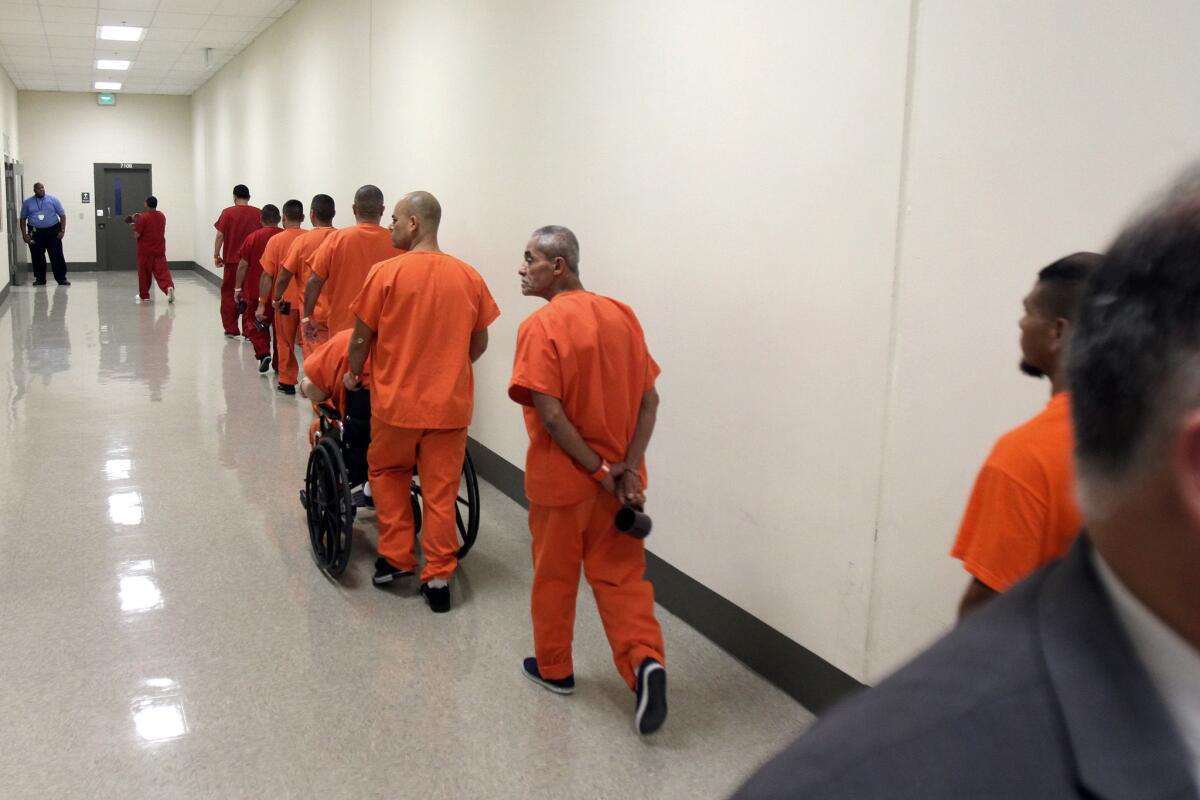Judge orders ICE to reduce number of immigrant detainees at California facility

- Share via
A federal judge on Thursday ordered immigration officials to significantly reduce the number of detainees held at the Adelanto ICE Processing Facility northeast of Los Angeles in order to protect them from the coronavirus.
U.S. District Judge Terry Hatter did not specify a number, but said that the population at Adelanto, one of the largest immigrant detention facilities in the country, must decrease “to such a level that would allow the remaining detainees to maintain a social distance of six feet from each other at all times.”
The ruling — the first of its kind in California — came in response to a lawsuit filed April 14 by the American Civil Liberties Union Foundation of Southern California and the law firm Latham & Watkins. A federal judge in Miami issued a similar ruling Wednesday but stopped short of the strict distancing requirement ordered by Hatter.
“Holding people in civil immigration detention in the midst of the COVID-19 pandemic without taking basic steps to protect them from infection from this deadly virus is, as the court found, ‘inconsistent with contemporary standards of human decency,’ ” said ACLU attorney Jessica Bansal.
Lawyers have contended that conditions at Adelanto make the facility vulnerable to an outbreak. Four to eight detainees live in cells as small as 8 by 10 feet and share toilets, sinks and showers.
ICE says detainees are regularly provided with soap and cleaning supplies. Facilities have increased social distancing by introducing staggered meals and recreation times, and suspending community service projects and social visits.
The agency said it has released 160 people deemed vulnerable since March 30 and limited intake of new detainees. Nationwide, 30,700 people are in ICE custody.
Hatter ordered ICE not to allow any new detainees at Adelanto and to reduce the population by at least 100 people by Monday and another 150 by April 30. By May 4, ICE should “hit the target reduced population level,” the order says.
He offered a few ways ICE can complete the task: by releasing selected immigrants; deporting those with final orders of removal who have exhausted all appeals; or transferring some to other facilities where they are able to maintain a six-foot distance from others.
Detainees say they are protesting conditions inside facilities that leave them at risk for contracting the novel coronavirus.
He encouraged ICE officials to prioritize for release detainees who are 55 and older or have preexisting medical or mental health conditions or who have no criminal history or minor criminal convictions.
Hatter also ordered Adelanto staff to maintain a six-foot distance from each other and from detainees except in case of emergency, to wear masks and gloves, and to provide cleaning supplies, masks and gloves to detainees for free.
If federal officials “fail to comply with any of the above, the Court will consider the immediate release of class members,” he wrote.
Adelanto has space for nearly 2,000 detainees but currently holds about 1,300.
About 31,000 immigrants are currently detained by ICE nationwide. As of Thursday, 297 detainees and 35 ICE employees at detention centers have tested positive for COVID-19.
The agency has come under scrutiny over protections for detainees as cases of the virus rise inside detention centers. Earlier this week, the ACLU filed class-action lawsuits seeking the release of detainees at the Otay Mesa Detention Center in San Diego, Imperial Regional Detention Facility in Calexico, Mesa Verde ICE Processing Center in Bakersfield and Yuba County Jail, north of Sacramento. Federal judges have already ordered the release of dozens of medically vulnerable detainees.
Immigrants held at Adelanto and other facilities launched hunger strikes in recent weeks over the lack of protective gear and adequate distancing. One detainee there said he had been mopping the floors of his unit with water because he wasn’t provided disinfectant.
More to Read
Sign up for Essential California
The most important California stories and recommendations in your inbox every morning.
You may occasionally receive promotional content from the Los Angeles Times.














